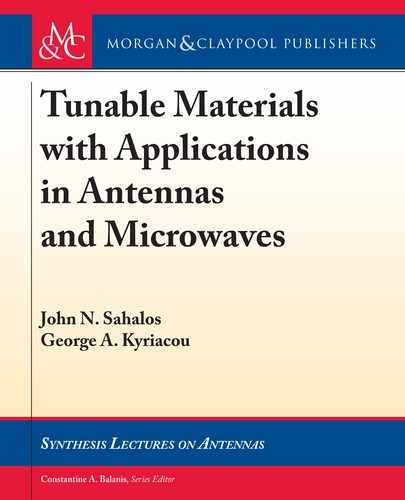
3.23. MAGNETOSTATIC SURFACE WAVES .1 C X / > 0 133
trast, for surface modes (MSSW), the x-dependence becomes hyperbolic or e
˙˛
i
x
. us, it is
obvious that the differentiation of ‰ will shift h
y
by ˙j D e
˙j 90
ı
but not h
x
, causing in general
elliptical polarization. Hence, MSBVW will be linearly polarized, while MSSW modes will be
elliptically (or circularly) polarized. With this opportunity, an examination of expression (3.91)
for transverse magnetization shows that magnetostatic forward volume waves (MSFVW) are
also linearly polarized.
3.23.4 POLARIZATION OF MSSW MODES
For an analytical examination of the polarization of MSSW modes, let us rewrite the magnetic
potential expression in the ferrite slab region with the help of (3.113) and (3.149) as:
‰
i
D f
i
.x/g.y/h.z/ D
1
sinh
.
˛
i
d
/
‰
0e
sinh
˛
i
x C
d
2
‰
0
0e
sinh
˛
i
x
d
2
e
jk
y
y
e
jk
z
z
:
(3.165)
In turn, the transverse RF magnetic-field components read as follows:
h
x
D
@‰
i
@x
D
˛
i
sinh
.
˛
i
d
/
‰
0e
cosh
˛
i
x C
d
2
‰
0
0e
cosh
˛
i
x
d
2
e
jk
y
y
e
jk
z
z
(3.166a)
h
y
D
@‰
i
@y
D
1
sinh
.
˛
i
d
/
‰
0e
sinh
˛
i
x C
d
2
‰
0
0e
sinh
˛
i
x
d
2
jk
y
e
jk
y
y
e
jk
z
z
: (3.166b)
Remember that the above expressions correspond to the complex phasors usually em-
ployed for the analysis of time-harmonic fields. eir formulas in the time domain are:
h
x
.t/ D Re
h
x
e
j!t
D f
0
i
.x/ cos
k
y
y k
z
z C !t
(3.167a)
h
y
.t/ D Re
h
y
e
j!t
D Cf
i
.x/k
y
sin
k
y
y k
z
z C !t
: (3.167b)
e angle of the transverse magnetic field
N
h
t
D h
x
Ox C h
y
Oy with respect to the x-axis,
(Figure 3.24), can be defined as:
tan D
h
y
h
x
, D tan
1
k
y
f
i
.x/
f
0
i
.x/
tan
k
y
y k
z
z C !t
: (3.168)
Recall at this point the basic definition of rotating, e.g., Pozar [3], for circular polarization:
N
H
t
D H
01
Ox jH
02
Oy: (3.169a)

134 3. FINITE FERRITE SAMPLES
h
t
h
x
h
y
x
θ
y
z
+
d
/2
-d/2
H
DC
,
M
S
Figure 3.24: Definition of the transverse RF magnetic field
N
h
t
and its angular dependence.
When H
01
and H
02
are real values, polarization is right-hand elliptical (RHEP) while
the expression
N
H
t
D H
01
Ox C jH
02
Oy; (3.169b)
yields a left-hand elliptical polarization (LHEP).
Hence, (3.168) shows that polarization is generally elliptical, and the direction of rotation
depends on the sign of k
y
, which is shown above to be different at the top x D Cd=2 and at the
bottom x D d=2 of the slab.
For a more convenient interpretation, let us examine the polarization on these surfaces in
the limiting case in which ˛
i
d >> 1 by exploiting expressions (3.164).
From (3.164a), on the top surface x D Cd=2 we have
h
x
‰
0e
˛
i
e
˛
i
.xd=2/
e
jk
y
y
e
jk
z
z
(3.170a)
h
y
‰
0e
jk
y
e
˛
i
.xd=2/
e
jk
y
y
e
jk
z
z
: (3.170b)
Taking the real values in the time domain
h
x
.t/ D ‰
0e
˛
i
e
˛
i
.xd=2/
cos
k
y
y k
z
z C !t
(3.171a)
h
y
.t/ D C‰
0e
k
y
e
˛
i
.xd=2/
sin
k
y
y k
z
z C !t
; (3.171b)
the angle of rotation becomes
D tan
1
k
y
˛
i
tan
k
y
y k
z
z C !t
: (3.172a)
Both k
y
and ˛
i
are real and positive and for the case in which k
z
0 expression (3.151)
gives k
y
D ˛
i
, which yields
k
y
y C !t
: (3.172b)
..................Content has been hidden....................
You can't read the all page of ebook, please click here login for view all page.
